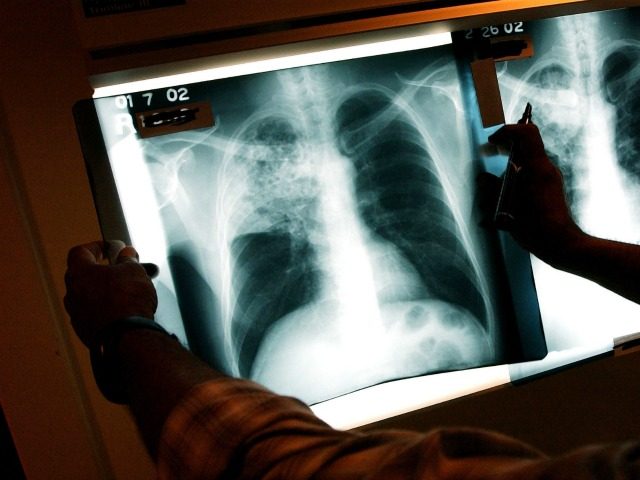The high rate of latent tuberculosis infection (LTBI) among refugees is a public health issue, Arizona state officials say.
“Most [of the] 222 cases of active tuberculosis infection (TB) …reported among Arizona’s refugee populations…[in] the past two decades …were caused by latent tuberculosis infections that became active after years or even decades of lying dormant,” according to the state’s Department of Health.
Eighteen percent “of all refugees resettled in Arizona arrive with a latent TB infection,” the 2014 Arizona Refugee Health Report states.
“For this reason,” the report adds, “it is important that those people discovered to have a latent TB infection complete an entire course of medication.”
The rate of LTBI among the general population is only 4 percent.
Active TB is infectious, while latent TB is not. Some 10 percent of those infected with latent TB develop active TB.
The disease is transmitted by airborne bacteria coughed, sneezed, or breathed out by a person with active TB and absorbed, usually through inhalation, by an uninfected person.
When an uninfected person absorbs the TB bacteria, they become LTBI positive. The disease remains latent until it is activated by a trigger, which is usually related to lower immune system defenses and increased stress.
The most current scientific research supports the concern expressed by Arizona public health officials about the high rates of LTBI among resettled refugees.
“Eighty percent of active TB cases in the U.S. are the result of reactivated LTBI, especially among individuals born in endemic areas,” a 2013 study by the University of Louisville Global Health Center concluded.
The high rate of LTBI among refugees, the significant percentage of arriving refugees who are not even screened for LTBI upon arrival, and very low rate at which refugees who test positive for LTBI complete successful treatment for it, are all reasons for the CDC to tighten its tuberculosis screening standards, as a December 2015 study by seven current and former CDC public health experts recommended:
Implementing LTBI [latent tuberculosis infection] screening and treatment for United States bound refugees from countries with high or moderate LTBI prevalence would potentially save millions of dollars and contribute to United States TB elimination goals. These estimates are conservative since secondary transmission from tuberculosis cases in the United States was not considered in the model.
The political leadership at the CDC, however, shows no indication it intends to change the policy to screen all refugees for LTBI overseas, despite the higher health risks posed by its current tuberculosis screening protocols.
As Breitbart News reported previously, other states have even higher rates of LTBI than Arizona: 22 percent in Minnesota and 26 percent in Indiana
Recent academic studies estimate that the rate of LTBI among all refugees ranges from 20 percent to 49 percent.
But the percentage of those refugees diagnosed with LTBI subsequent to their arrival in the United States who either fail to begin treatment or fail to complete it once started is very high.
In Kentucky, for instance, 73 percent of recently arrived refugees who tested positive for LTBI did not successfully complete a treatment program, as that 2013 study published by the University of Louisville Global Health Center concluded:
The lack of adherence to treatment for LTBI has been a long-standing problem. Our 27% rate of treatment completion is consistent with published literature on low adherence rates to treatment among high risk populations.
Tuberculosis represents an important global health burden, with more than 9.2 million cases of reactivation of LTBI and 1.5 million deaths per year.
Eighty percent of active TB cases in the U.S. are the result of reactivated LTBI, especially among individuals born in endemic areas.
Therefore, it is crucial that refugees are screened for LTBI and that appropriate access to treatment and adherence to therapy are ensured.
That means these LTBI positive refugees are at risk of activating their TB, at which point they become infectious and can transmit the disease to others.
A significant percentage of resettled refugees never complete their health screenings, so they may be wandering around, untreated, for any of a number of diseases, which include tuberculosis, but also include intestinal parasites, whopping cough, diphtheria, measles, scabies, leprosy, and HIV.
The rate of failure to complete health screenings-recommended by the Centers for Disease Control (CDC) but not required by law or regulation varies by state. In Indiana, 23 percent of newly arrived refugees were not screened because they never showed up for their appointments, for instance. In Texas, that number is only 9 percent.
Defenders of the refugee resettlement program in the United States claim that the high rate of LTBI among resettled refugees poses no tuberculosis health risk to the rest of the population. They make the same argument as does the World Socialist Website, published by the International Committee of the Fourth International, which recently claimed that “latent TB poses no immediate threat to public health.”
That claim, however, is belied by the report from the Indiana Department of Health that four newly arrived refugees in the Hoosier State tested positive for active tuberculosis in 2015.
CDC screening either missed these active cases of TB overseas, or these were patients who had LTBI that activated subsequent to their arrival in the United States but prior to their initial health screening in Indiana.

COMMENTS
Please let us know if you're having issues with commenting.